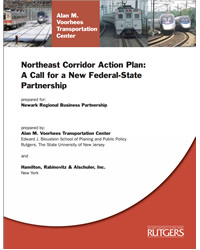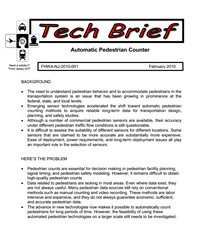Rutgers University-Newark & NJ TRANSIT TDM Partnership Andrea Lubin and Pippa Woods, 60 pages. A final memorandum prepared for Rutgers...


Rutgers University-Newark & NJ TRANSIT TDM Partnership Andrea Lubin and Pippa Woods, 60 pages. A final memorandum prepared for Rutgers...

Viability of Personal Rapid Transit In New Jersey Jon Carnegie and Paul Hoffman. A report prepared for the New Jersey Department of Transportation...
NJ Energy Master Plan and Greenhouse Gas Initiative (December 2011)
Northeast Corridor Action Plan: A Call for a New Federal-State Partnership Martin E. Robins, 36 pages. A report prepared with Hamilton, Rabinovitz...

Georges Road Gateway Planning Project VTC staff and a student project team, 61 pages. Prepared for Radha Jagannathan, Ph.D., and Michael J. Camasso,...
Energy Consumption and the Commute to Work VTC staff in association with Jeffrey Zupan, 4 pages. A working paper prepared for the Center for Energy,...

The Impacts of Office Location on the Commute Experience of New Jersey Workers This study examined the effects of NJ office locations on personal...

I-287 Mobility Report 148 Pages, June 2005. Final Report

Penn's Neck Final Environmental Impact Statement Record of Decision 27 Pages, May 2005. Executive Summary 47 Pages. December 2004.

Before-After Evaluation of NJDOT Bypass Projects VTC is conducting case-study research to review the traffic, circulation, economic and community...
From labor-saving inspection drones to safety-enhancing techniques for bridge repair and preservation, a multipronged New Jersey Department of Transportation technology transfer initiative is helping to advance innovation throughout the agency and state. The goal:...
With improved portability and affordability, eye tracking devices have facilitated an expanding range of cycling experiments aimed at understanding cycling behavior and potential risks. Given the complexity of cyclists’ visual behavior and gaze measurements, we...
We contribute to the literature on new mobilities by measuring spatial disparities in travel times for accessing essential non-work destinations via ridehailing. We focused on healthcare, restaurants, and grocery destinations in Chicago. Data from Chicago ridehailing...
How and why do zero-car households seek car access? We used a national online survey of 830 American adults and interviews with twenty-nine low- and moderate-income travelers about their car access behaviors to answer this question. We validated our findings with the...